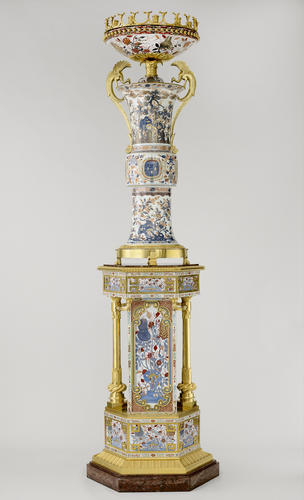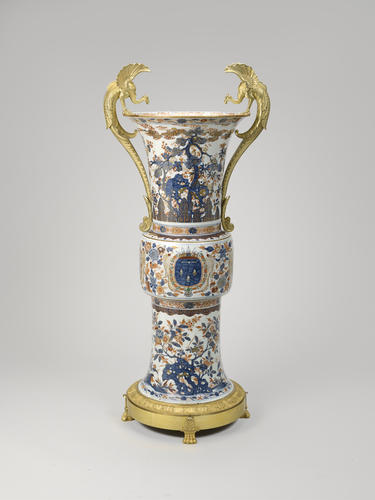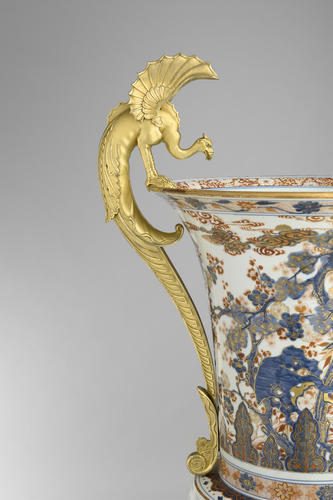Set of vases mounted as oil lamps, with stands vases: 1710-25, mounts: first quarter 19th century
Porcelain painted in underglaze blue, iron-red enamel and gilt | 287 x 62 cm (whole object) | RCIN 204

China
Set of vases mounted as oil lamps, with stands vases: 1710-25, mounts: first quarter 19th century

China
Set of vases mounted as oil lamps, with stands vases: 1710-25, mounts: first quarter 19th century

China
Set of vases mounted as oil lamps, with stands vases: 1710-25, mounts: first quarter 19th century




-
A set of Chinese porcelain vases bearing the arms of Orléans and the families of Vergèze d'Aubussargues and de La Perrière, mounted with additions of nineteenth-century English gilt bronze and Spode pottery as standing oil lamps, with stands.
Each vase a cylindrical beaker of gu shape, spreading towards the foot and the open mouth above, with a projecting band round the centre; the unglazed base recessed within the foot. Three of the vases are painted round the centre with the arms of the duc d'Orléans (Regent of France) repeated four times, each upon a roundel with a blue field, three fleurs-de-lys and a label of three points, all within a collar ensigned with a coronet, surrounded by the collars of the orders of the Holy Spirit and of St Michael imprecisely rendered, within a cartouche. The remaining three have a different armorial of two conjoined roundels, each with a blue field on a cartouche. On the dexter, five cinquefoil and a Talbot argent, and on the sinister, three pineapples and a chevron, all within a collar ensigned with a coronet, identified as those of Vergèze d'Aubussargues of Languedoc and de La Perrière of Franche-Comté. On all the vases, between the arms are painted linked sprays of peony, chrysanthemum and other flowers; and decorating the body below are peonies and other plants growing by rocks, between narrow borders of chrysanthemums and prunus; on the neck are pine, prunus and bamboo trees growing by rocks, with swirling clouds above, between spearhead and chrysanthemum borders.
Flanking the neck is a pair of gilt-bronze dragon handles, their feet perching on the top rim, their slender pendent tails reaching down to the bulbous shoulder. Borne above the dragons is a shallow lamp bowl of Spode china; supported on an open lotus flower with a central rod running up within the vase, the bowl painted with matching flower sprays. Four of the vases with rims fitted with a band of gilt-bronze pearls below a ring of linked scrolls issuing husks resembling a coronet. The gilt-bronze base fitted to the vase is a shallow drum with leaf-cast ring above four paw feet, each with a palmette above, standing on a hexagonal pedestal with a rouge griotte marble top with gadrooned edge (one marked 'F', another marked 'O'), and wooden painted frame enclosing a frieze of rectangular panels of painted Spode pottery with gilt-bronze, angular frames. This is supported by a tall, square-sectioned column with panels of Spode ware painted with conforming floral subjects to accord with those of the vase and with scrolling gilt-bronze enrichments, enclosed in a painted, wooden, upright frame. At each side is a pair of tubular gilt- bronze posts with reeded upper branches and rope-twist bases, rising from a similar but deeper hexagonal plinth below. The base is attached to a spreading, panelled, gilt-bronze foot raised on a hexagonal base of rouge griotte marble.
Text adapted from Chinese and Japanese Works of Art in the Collection of Her Majesty The Queen: Volume I.Provenance
The three vases with the arms of Philippe II (1674–1723), duc d’Orléans, Regent of France (1715–23), evidently from his collection. The other three vases in the collection member of the families of Vergèze d’Aubussargues of Languedoc and [the marquis] de La Perrière of Franche-Comté. No doubt all originally ordered from China through the French East India Company, along with others bearing the royal arms of France (such as RCINs 2395 and 204).
Purchased for George IV when Prince Regent in Paris in 1817 by Jean-Baptiste Watier (active 1817), and despatched to the Royal Pavilion, Brighton on 22 November, as recorded by Benjamin Jutsham (Jutsham Recs ii.14–15).
Benjamin Vulliamy undertook their conversion into lamps with the Spode additions, at a cost of £1,836 6s 6d. They were installed as lamps in the corners of the Music Room at the Royal Pavilion, Brighton, where they were illustrated by John Nash in 1826. They are described in the inventory there (1829B) and in March 1847 were brought to Buckingham Palace as part of the furnishings for the newly built East Wing. They were noted in the Centre Room, and in particular the ‘Pavilion Breakfast Room’ (now known as the Chinese Dining Room), as recorded in James Roberts’s (c.1800–67) watercolour of 1850. -
Creator(s)
(nationality)(metalworker)(porcelain manufacturer)Acquirer(s)
-
Medium and techniques
Porcelain painted in underglaze blue, iron-red enamel and gilt
Measurements
287 x 62 cm (whole object)
H (overall) 300.0 cm; (vase only) 99.0 cm (whole object)
84.0 cm (Width) x 68.0 cm (Depth) (at base of object)
Other number(s)








